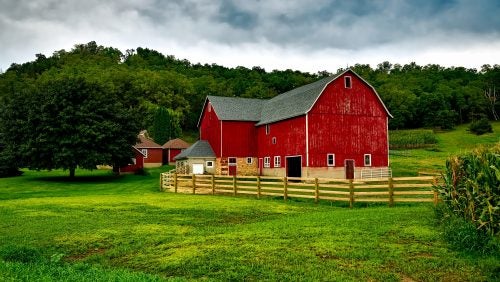Can the Farm Bill Address Climate Change?
December 22, 2022 by Damon Hays

Red Farm House
The industrial style of agricultural production practiced in the United States perfectly illustrates the nation’s relationship with the changing climate. Agriculture is a major contributor to greenhouse gas emissions while also facing the rapid rise of significant threats to its continuation. Increased floods across some areas and severe droughts in others, coupled with the increasing salinization of surface and groundwaters, can lead to lower crop yields, loss of pasture for livestock maintenance, and weakened nutritional value for a variety of crops. [1] These are only a few of the numerous adverse effects of the warming globe on national food production.
These threats loom as agriculture represents an estimated 11.2% of domestic greenhouse gas emissions. [2] Since these emissions consist primarily of nitrous oxide and methane, they have significantly greater warming impacts than carbon dioxide. [3] However, attributing agriculture’s effects on climate change only to emissions would minimize the indirect effects of the system of nonlocal production. Pollution from transporting foodstuffs and the conversion of soil from a carbon sink to a carbon source through reckless tilling and furrow practices are comparable consequences. [4]
Next year will see the convening of a new Congress, and with it will come the expiration and need for reauthorization of the Farm Bill, sweeping legislation which covers all forms of agricultural production in the United States. [5] This reauthorization presents an opportunity for Congress to take significant steps in addressing food production’s contribution to climate change. In a letter to President Biden, over 150 agriculture, environmental, and labor groups have included a call for such action, asking the administration to “Demand a Farm Bill that Reflects [Biden’s] Values.” [6]
There has already been some indication of an existing political will to meet agriculture’s climate defects head-on. The Inflation Reduction Act of 2022 provided $19.5 billion in funding for existing Farm Bill conservation programs. [7] This funding was primarily aimed at the Environmental Quality Incentives Program (EQIP), [8] a voluntary conservation program that provides funding and technical assistance to participating producers promoting emissions and environmental degradation-reducing practices such as cover crop usage, prescribed grazing and tillage management. [9]
While the encouragement of such practices is undoubtedly a necessary step toward climate-conscious agriculture, EQIP’s reach remains limited. In 2021, the USDA reported that under two percent of the 895 million acres of farmland in the contiguous United States were engaged in EQIP practices. [10] While this number assuredly underestimates the coverage of all conservation efforts, it illustrates the gulf between agriculture’s harm and the effort to curb those ills.
In order to take the necessary leap in overcoming such an ecological gulf, the upcoming Farm Bill must take targeted action in addressing climate change. This should start with the inclusion of a Title in the bill dedicated to the warming climate for the first time since the Farm Bill of 1990. [11] The Climate Change Title may include actions such as increased funding for emission reduction practices, rewarding operations that already engage in such practices, and, at the end of proposals, conditioning portions of the vast crop and livestock subsidies and insurance on the implementation of sustainable practices.
The inclusion of any climate provisions in the bill will, of course, depend on whether the upcoming Congress recognizes the desperation of the climate crisis and is prepared to combat it. Republican control of either chamber would place the possibility of such measures in serious doubt. The ranking Republican on the Senate Committee for Agriculture, Nutrition, and Forestry, John Boozman, and presumptive Chair of the House Agriculture Committee Glenn Thompson, have both voiced misgivings at the inclusion of new climate measures. [12]
The future of agriculture and food production depends on effectively managing the climate crisis. Agriculture’s contributions to the crisis necessitate steps toward curbing the worst of industrial-style production excesses, and the Farm Bill of 2023 has the potential to take those steps. Whether the political will to take such steps can materialize in the coming months is an open question to which we will soon have the answer.
Citations
- EPA, Climate Impacts on Agriculture and Food Supply, https://climatechange.chicago.gov/climate-impacts/climate-impacts-agriculture-and-food-supply (last visited Oct. 20, 2022).
- U.S.D.A., Climate Change (2022) https://www.ers.usda.gov/topics/natural-resources-environment/climate-change/#:~:text=U.S.%20agriculture%20emitted%20an%20estimated,carbon%20dioxide%20(EPA%202022).
- EPA, Understanding Global Warming Potentials, https://www.epa.gov/ghgemissions/understanding-global-warming-potentials (last visited Dec. 10, 2022).
- Virginia Gewin, The World Food Prize Winner Says Soil Should Have Rights, Civil Eats (July 15, 2020), https://civileats.com/2020/07/15/the-world-food-prize-winner-says-soil-should-have-rights/.
- Agriculture Improvement Act of 2018, Pub. L. No. 115-334, 132 Stat 4490 (2018).
- Letter from A Better Balance to Pres. Joseph R. Biden (Sept. 13, 2022), https://ucs-documents.s3.amazonaws.com/food-environment/Transformational-Farm-Bill-Letter-Final.pdf.
- Jonathan Coppess et al., Reviewing the Inflation Reduction Act of 2022; Part 1, Farmdocdaily (Aug. 11, 2022), https://farmdocdaily.illinois.edu/2022/08/reviewing-the-inflation-reduction-act-of-2022-part-1.html.
- Id.
- U.S.D.A., Environmental Quality Incentives Program, https://www.nrcs.usda.gov/wps/portal/nrcs/main/national/programs/financial/eqip/ (last visited Oct. 20, 2022).
- U.S.D.A., NRCS Conservation Programs: Environmental Quality Incentives Program (EQIP), https://www.nrcs.usda.gov/Internet/NRCS_RCA/reports/fb08_cp_eqip.html (last visited Oct. 20, 2022).
- Jonathan Coppess, Climate Change and the Farm Bill: A Brief History, Farmdocdaily (Sept. 29,2022), https://farmdocdaily.illinois.edu/2022/09/climate-change-and-the-farm-bill-a-brief-history.html.
- John McCracken, Will the Farm Bill be the next big climate package? It depends on the midterm elections., Grist (Oct. 3, 2022), https://grist.org/agriculture/midterm-elections-future-farm-bill/.

